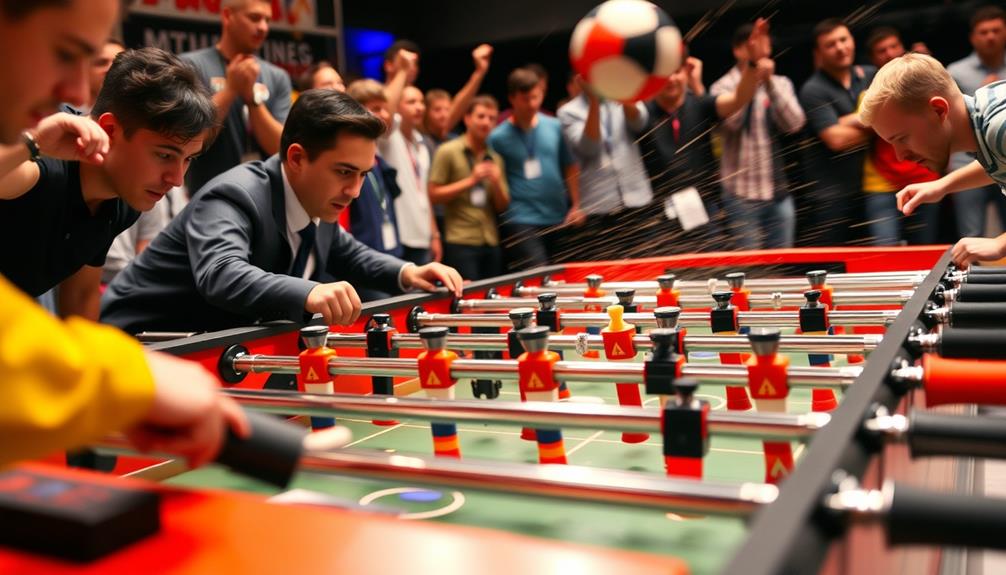Arcade games, specifically claw machines, are commonly set up in a way that maximizes profits and encourages players to keep spending money. The claw’s grip strength is usually deliberately weakened, making it difficult to successfully win prizes. Players often notice a win rate of only 10-20%, resulting in many leaving empty-handed. Operators manipulate the machines to limit wins, playing on the players’ emotions with “near wins.” Additionally, the odds are adjusted to make winning seem like a matter of luck rather than skill. If you’re interested in how these tactics impact your chances of winning and overall player experience, there’s much more to learn on this subject.
Key Takeaways
- Claw machines often have adjustable claw strength and are set to weak, limiting players' chances of winning.
- The average chance of winning in claw machines ranges from 10-20%, with odds manipulated to favor the arcade.
- Operators can program machines to restrict successful wins within a certain timeframe, maximizing profits at players' expense.
- Emotional manipulation through "near wins" exploits player psychology, encouraging repeated attempts despite low success rates.
- Lack of transparency, such as the removal of instruction manuals, contributes to distrust in arcade game fairness and operations.
Understanding Claw Machine Mechanics
When you approach a claw machine, it's vital to understand how its mechanics work to grasp why winning can feel so elusive. These machines are designed with adjustable claw strength, which is often set to be weak. This means that, most of the time, you're grappling with insufficient grip to lift those tempting prizes.
The typical chance of winning is deliberately low, with payout rates between 10-20%, making it akin to the challenges faced in 10 Steps to Recording Songs on Cassette Tapes where mastering techniques is essential for success. You might find yourself trying an average of 18 times before securing a win, which can be frustrating.
Operators manipulate claw pressure, usually set around 5-8 PSI, making those coveted toys even harder to snag. Game manuals often reveal that claw machines might've predetermined win rates, ensuring a payout only after a specific number of attempts. This reinforces the sense that these machines are rigged against you.
Moreover, claw machines are designed to create the illusion of skill. Near-wins can trick you into thinking you're close to victory, encouraging you to keep playing despite the low chances of winning.
Ultimately, understanding these mechanics can help you make more informed choices when approaching these deceptive games.
The Role of Arcade Owners

Understanding the mechanics of claw machines sheds light on the role of arcade owners in shaping your gaming experience. These owners use Command Module Settings (CMS) to manipulate the outcomes of claw games, typically rigging the odds to about 1 in 12 in California and 1 in 15 in Nevada.
They know how to adjust the claw pressure, often setting it between 5-8 PSI, which is usually not strong enough to lift prizes during most attempts. This manipulation of claw machines resembles practices noted in other industries, such as personality tests, where outcomes can be influenced by underlying frameworks.
Arcade owners are savvy when it comes to maximizing their profits. Many machines are programmed to allow only a limited number of successful wins within a specific timeframe, meaning you might try repeatedly without success. This strategy encourages players to keep pumping in coins or tokens in the hopes of eventually scoring a win. Additionally, the difficulty of arcade games can be adjusted by the owner, making them more or less challenging as needed. Some arcade games also offer enticing prizes for those who are able to beat the high score or reach a certain level, creating further incentive for players to continue playing.
The manuals for claw machines confirm that grip strength can be altered, reducing winning chances and enhancing operator revenue.
This practice raises ethical concerns about transparency and fairness. Players often remain unaware of these manipulations, leading to frustration and disillusionment.
As you engage with claw machines, remember that the odds are often stacked against you, thanks to the strategic choices made by machine owners designed to benefit their bottom line.
Winning Odds and Player Disadvantages

Winning at claw machines often feels like chasing a mirage, with the odds stacked heavily against you. The average winning odds are manipulated by operators, typically set between 1 in 12 and 1 in 18, depending on the location and game settings. This means you may face a statistical disadvantage, as about 11 out of 12 attempts could end in failure.
In a similar way to how camping locations can vary in accessibility and conditions, the gaming environment at arcades can also play a significant role in your experience, as there are often unique challenges to take into account.
Even if you're determined, the claw machine's grip strength is often adjusted to apply insufficient pressure during most attempts. This makes it incredibly challenging to successfully retrieve prizes, leaving you frustrated after repeated efforts.
Manuals for these machines reveal that operators can alter the grip strength, reinforcing the idea that outcomes depend more on luck than skill.
Many players remain blissfully unaware of these rigged mechanics and the low odds of winning, which only fuels the cycle of repeated attempts. The allure of potential success keeps you coming back, despite the player disadvantages stacked against you.
Understanding these factors can help you make more informed choices when it comes to playing claw machines and enjoying arcade games.
Ethical Concerns in Game Design

The allure of arcade games often masks significant ethical concerns in their design. For instance, claw machines are notorious for being rigged, leading to player frustration. While marketed as skill-based, operators can adjust winning chances, setting you up for disappointment.
| Ethical Concerns | Player Experience | Operator Profit |
|---|---|---|
| Lack of transparency | Low success rates | Prioritizes profits |
| Emotional manipulation | "Near wins" exploit | Deceptive practices |
| Fixed attempts before wins | Increased frustration | Unfair gameplay |
| Need for regulation | Misleading marketing | Consumer exploitation |
These games often show a 1 in 12 chance of winning, especially in places like California. It's disheartening when you realize that claw machines might only allow wins after several attempts, making it feel like you're being strung along. The psychological tactics at play, like near wins, compel you to keep trying despite the odds. As players, you deserve transparency and fairness, which is why there's an ongoing debate about stricter regulations in the gaming industry. Ethical concerns in arcade games aren't just about losing; they're about how the games manipulate your experience.
Cultural Perceptions of Arcade Games

Arcade games, especially claw machines, have captured players' hearts and sparked nostalgia, even as many know they're rigged. You might still find yourself drawn to the flashing lights and the thrill of the chase, despite the frustration of losing.
The perception of these games as fair skill challenges persists, often because you may not fully grasp the low probabilities of winning due to operators manipulating the settings. Engaging with these games can be likened to the benefits of music therapy integration where emotional well-being is fostered through enjoyable experiences, albeit with a different focus.
Social media amplifies this cultural engagement, showcasing successful plays that create a fear of missing out (FOMO). When you see your friends triumphantly posting their plush haul, it drives you to try your luck again, hoping to replicate that success. This emotional investment in claw machines leads to repeated attempts, reinforcing their status as both sources of entertainment and frustration.
As public awareness of rigging grows, discussions about the ethics of arcade gaming have emerged, highlighting a demand for greater transparency from operators. While you might enjoy the thrill of the game, it's crucial to recognize the underlying mechanics that shape your experience.
Ultimately, the cultural perceptions surrounding arcade games reflect a complex blend of nostalgia, excitement, and ethical considerations.
Impact of Social Media Revelations

Social media revelations have considerably shifted how people view rigged arcade games, particularly claw machines. Platforms like TikTok have played an essential role in exposing adjustable success rates in these machines, with influencers such as Katie Clark racking up over 120,000 views on her videos. This newfound awareness has led to increased scrutiny about fairness in gaming environments.
Here's a quick look at how social media impacts perceptions of claw machines:
| Aspect | Impact |
|---|---|
| Visibility | Influencers share rigging insights |
| Community Reactions | Users discuss frustrations |
| FOMO | Players engage despite knowing rigged nature |
As discussions unfold, you can see players sharing their own experiences and suggesting non-rigged experiments. The fear of missing out (FOMO) drives many to play these machines, even when they recognize their rigged nature. Additionally, recent actions, like BMI Gaming's removal of publicly available instruction manuals, raise alarms about transparency in the arcade industry, further intensified by social media dialogues. In this evolving landscape, it's essential for you to stay informed and skeptical about the games you choose to play.
Frequently Asked Questions
Why Are Arcades Allowed to Rig Games?
Arcades are allowed to rig games due to loose regulations and their classification as games of chance. This lets operators manipulate odds, enhancing profits while keeping players engaged with the thrill of potential wins.
Are Arcade Grabbers Rigged?
You might think you're close to winning, but those claw machines aren't your friends. They're rigged with weak grips and adjusted settings, making it tough to snag a prize, despite what you believe.
Is There a Trick to Claw Machines?
To improve your chances at claw machines, observe previous attempts and try the double-tap technique. Remember, though, the machines are often set to limit wins, so don't get too discouraged if you don't succeed.
How Do You Win Arcade Games Easily?
"Practice makes perfect." To win arcade games easily, observe others, adapt your strategy, and understand each game's mechanics. Set a budget, enjoy the experience, and remember that patience and skill often lead to success.
Conclusion
In the world of arcade games, the glimmer of victory often hides a dark truth. Just like a mirage in the desert, the allure of winning can lead you astray. Behind the flashing lights and cheerful sounds, rigging can turn your fun into frustration. As players, you deserve transparency and fairness. Let's shine a light on these practices, demanding honesty from arcade owners, so every game feels less like a gamble and more like a genuine chance to win.









